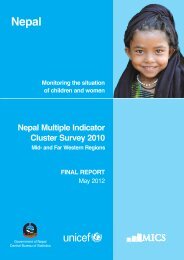Chapter 15 Internal Migration in Nepal - Central Bureau of Statistics
Chapter 15 Internal Migration in Nepal - Central Bureau of Statistics
Chapter 15 Internal Migration in Nepal - Central Bureau of Statistics
You also want an ePaper? Increase the reach of your titles
YUMPU automatically turns print PDFs into web optimized ePapers that Google loves.
<strong>15</strong>.5 Summary and Conclusion<br />
<strong>15</strong>.5.1 Summary<br />
In 2001, <strong>Nepal</strong> had a population <strong>of</strong> 23.<strong>15</strong> million with an annual growth rate <strong>of</strong> 2.25 per cent.<br />
High fertility rate <strong>of</strong> 4.1 children per woman and a huge population <strong>in</strong> the reproductive age will<br />
cont<strong>in</strong>ue to exasperate poverty and <strong>in</strong>crease migration <strong>in</strong> <strong>Nepal</strong>.<br />
In 2003, <strong>Nepal</strong>'s population is estimated to have reached 25.1 million with a density <strong>of</strong> 179<br />
persons per square kilometer. <strong>Nepal</strong> ranked 143 rd <strong>in</strong> human development <strong>in</strong>dex <strong>of</strong> 2003. Every<br />
two <strong>in</strong> five persons <strong>in</strong> <strong>Nepal</strong> lives below absolute poverty l<strong>in</strong>e and every other person <strong>in</strong> the rural<br />
area is poor. Poverty, high unemployment and underemployment (17.4 and 32.3%) have<br />
compelled people to rema<strong>in</strong> either under severe poverty or migrate to other places with<strong>in</strong> and<br />
outside the country for better opportunity for livelihood.<br />
The uneven distribution <strong>of</strong> population has led to a high disparity <strong>in</strong> population density <strong>in</strong> different<br />
ecological zones. The Tarai zone had the highest density <strong>of</strong> population s<strong>in</strong>ce 1952/54 followed by<br />
hills and mounta<strong>in</strong>s. Population density <strong>in</strong> <strong>Nepal</strong> <strong>in</strong>creased dramatically over time reach<strong>in</strong>g <strong>15</strong>7<br />
persons per square kilometer <strong>in</strong> 2001 and would reach 200 persons per square kilometer by 2005<br />
at the present rate <strong>of</strong> population growth rate.<br />
The absolute volume <strong>of</strong> <strong>in</strong>ter-district migration <strong>in</strong>creased by 7 times dur<strong>in</strong>g the last 40 years and<br />
that <strong>of</strong> <strong>in</strong>ter-regional migration volume <strong>in</strong>creased by 4 times s<strong>in</strong>ce 1971. The volume <strong>of</strong> life-time<br />
migration at the district level <strong>in</strong>creased from 1.7 million <strong>in</strong> 1991 to 2.9 million <strong>in</strong> 2001. This<br />
constituted 13.2 per cent <strong>of</strong> the total native born population <strong>in</strong> <strong>Nepal</strong>. <strong>Migration</strong> streams from one<br />
region to another were directed towards their own neighbour<strong>in</strong>g regions.<br />
Prelim<strong>in</strong>ary analysis suggests that there is a high <strong>in</strong>cidence <strong>of</strong> poverty <strong>in</strong> the regions experienc<strong>in</strong>g<br />
net negative migration and that regions <strong>of</strong> <strong>in</strong>-migration are relatively better <strong>of</strong>f <strong>in</strong> development<br />
<strong>in</strong>dicators. People <strong>in</strong> <strong>Nepal</strong> are migrat<strong>in</strong>g from poverty stricken rural areas <strong>of</strong> low density to urban<br />
areas <strong>of</strong> high density and to areas <strong>of</strong> fertile agricultural land <strong>in</strong> the Tarai.<br />
In <strong>Nepal</strong>, the major streams <strong>of</strong> <strong>in</strong>ternal migration are rural-to-rural (68.2%) and rural-to-urban<br />
(25.5% <strong>in</strong> 2001 and 31.2% <strong>in</strong> 1996). Urban-to-urban (2.8%) and urban-to-rural (3.5) are <strong>of</strong> lesser<br />
importance. <strong>Nepal</strong> has at present 58 designated urban centres with a total population <strong>of</strong> 3,227,879.<br />
Out <strong>of</strong> this total, 95.6 per cent were native born and 4.4 per cent were foreign born <strong>in</strong> 2001. Out <strong>of</strong><br />
<strong>15</strong>5
















